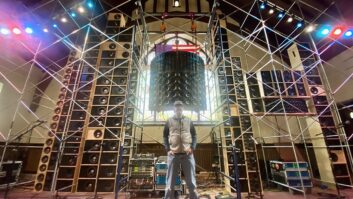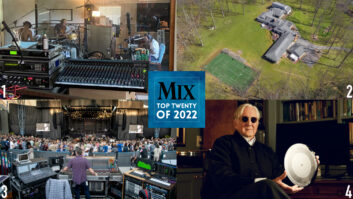
 This was Mix’s 3rd most-read article of 2022!
This was Mix’s 3rd most-read article of 2022!
New York, NY (August 11, 2022)—It just isn’t summer unless Dead & Company is coming to town. Founded in 2015, the supergroup—featuring Grateful Dead mainstays Bob Weir, Bill Kreutzmann and Mickey Hart; singer/guitarist John Mayer; former Allman Brothers Band bassist Oteil Burbridge; and RatDog keyboardist Jeff Chimenti—has played every year since (yes, even 2020, thanks to some early winter shows), grossing more than $300 million in the process. Live sound provider UltraSound has worked with the Grateful Dead and its spinoffs since 1978, so this year’s tour, which wrapped up in mid-July, found the Petaluma, Calif., company’s CEO, Derek Featherstone, once again mixing the band (and working as tour director), much as he has on Dead live projects for decades.
The group’s music has always been based around improvisation, so Featherstone in turn has an ad-libbed approach to mixing its shows. “You do a line check in the daytime, getting your rough levels and tones on instruments, and you can get 80 percent there without the band,” he said. “The first 10 seconds of the first song is where you get the other 20 percent in place—and then you follow them. You’re definitely reacting to what they’re doing, because they’re going out on a limb to do something, so you’re running there with them or maybe holding them back a little bit because they went too far! You have to take a very reactive approach to mixing their improvisation—your brain gets 30 milliseconds to say, ‘Is this good or bad? Okay, make that louder, it’s good.’”
If the musicians are forever exploring new terrain, they have a familiar foundation of audio gear and personnel to support their efforts. Featherstone mixes nightly behind a custom Gamble EX66 console—a mainstay on Dead shows since 1992, except for a few years in the late 2000s, when a digital desk was used for spinoff Furthur. “I don’t know how many bands out there these days are touring without any sort of additional support, meaning electronics or pitch correction and so on,” he said. “The fact that I’m leaning on an analog console for so much of it has forced us to play fair, too; you can’t cheat.”
That said, a digital Avid S6L-24D console also lives at the house mix position, holding inputs 67-117 for the Gamble, but it is additionally set up to replicate the entire Gamble desk if necessary, complete with appropriate plug-ins emulating the mostly analog outboard gear onhand. The outboard units in question?
“I’m leaning heavily on products from the 1980s,” says Featherstone. “It goes from tc electronic M5000s to dbx 160 compressors, some Summit Audio DCL- 200s and TLA-100s, a couple of original UREI LA-3As, Empirical Labs Distressors, Aphex Expressors and more. One of the things I’ve just added on this tour is the SSL G Bus+ Compressor, which I’m using on the kick drum of all things; it’s an incredible compressor that I’m quite happy with.”

It’s not the only new addition, however, as this year’s journey was the first U.S. tour to carry Meyer Sound’s new flagship Panther P.A. system. The manufacturer is another entity with Grateful Dead connections reaching back to before the company began in 1979, as co-founder John Meyer was involved in the development of the band’s legendary Wall of Sound P.A. system in 1974.
With this year’s tour playing a mix of sports stadiums and larger sheds, UltraSound carried a fair amount of Panther inventory to tackle the variety of venues. For stadiums, four identical arrays graced the stage, with two main front and two side hangs, all sporting 14 Panther loudspeakers, with four Panther-W wide coverage versions flown under 14 Panther-L long-throw versions. They were supported by 18 flown 1100-LFC low-frequency control elements plus a dozen 700-HP subwoofers on the ground. Also employed were 10 VLFC very low-frequency control elements and 12 Leopard compact line array loudspeakers used as front fill, all under the control of eight Galaxy Network Platforms used for system drive and optimization.

How new was the P.A.? “I was so busy putting this tour together,” said Featherstone, “that I never had a chance to even listen to it until I turned it on at Dodger Stadium! Take that as a testament to our faith in Meyer. They’ve never made a brand-new product that went the wrong direction; it’s always gotten better and better.”
As a result, Featherstone found himself discovering Panther’s abilities as the tour progressed: “It’s got some different characteristics. It’s a very reactive P.A., so you’re mixing a little more accurately; you don’t want to push something as hard as you might have in the past, because it’ll jump out at you. I’ve also noticed it allows you to get more precise with compression; on vocals, for instance, I have a bunch of tube compressors I use, and I can hear the characteristics of those compressors better on this system. You do a tiny move with this system EQ and you see it respond real quick— you make a move, you hear it, you move on. Its high frequency is very full at decent distances, it doesn’t trail off on the high end…it’s a full-range, smooth cabinet.”
Below that P.A. were a bevy of mics capturing every musical twist and turn on stage, including Featherstone’s go-to favorite for vocals—the Sennheiser e 935. “That allows a singer to lean on or off the mic without their tone changing,” he noted. “If you’ve got someone like Bob Weir who sings very heavy on the mic, but then drifts off seven inches, you don’t get this tiny, little voice coming out; you get the same big voice but quieter.” Another Sennheiser put to use was an MKH 8020 condenser on the snare, as Featherstone finds it helps glue hi-hat spill and a transparent snare sound together in a more musical way. Elsewhere, John Mayer’s guitar was captured with both a Sennheiser MD 421 and the discontinued MD 409. “The 421 couples nicely with his speakers and helps create a signature Grateful Dead tone,” Featherstone explained.
One of the more unlikely mics onstage, however, was a Schoeps MK 41, borrowed from UltraSound’s symphony miking package and applied to the Hammond Leslie cabinet. “We don’t usually cross-pollinate the symphony microphones with the rock’n’roll stuff,” he said with a laugh, “but there was this idea to put that very directional, high-end microphone on there. We control its bleed with a gating system that turns those mics off automatically, so when the instrument comes on, it’s a big, very helpful, full-frequency reproduction of it.”
While there were some monitor speakers onstage—10 Meyer Sound MJF-210 and two MJF-212A stage monitors along with two JM-1P loudspeakers for side fill and two 1100-LFC elements as drum subs—the band mostly listens to itself via in-ear monitors. Monitor engineer Lonnie Quinn tackled mixes at stageside on an Avid S6L 32D console, with fellow monitor man Ian Dubois mixing for Hart on an Avid Profile. Most bandmembers wear two IEMs, while Mayer has been sporting Audio-Technica headphones in recent times to hear the house mix with his guitar on top. Meanwhile, Chimenti and Weir each opt to wear a single ear monitor. “It’s a real quiet stage volume; Bob Weir has been an advocate of that forever,” said Featherstone.
With this year’s Dead & Company jaunt now over, Featherstone has relinquished his tour director and FOH engineer roles for a while, returning to “only” running an audio company with a slew of major tours out. Still, it won’t be long before he’s back in the mix position, supporting the band’s improvisational flights of fancy, no matter where they lead. “It just goes and you follow it,” he said. “It’s the same mentality that the fans have: They’re going to the show not knowing what’s going to come out of it—and we’re doing the same thing with audio!”







